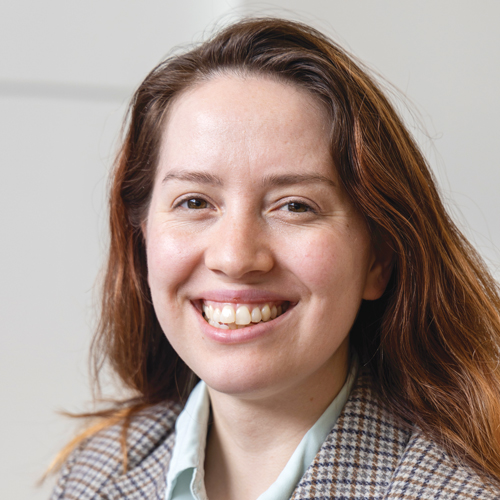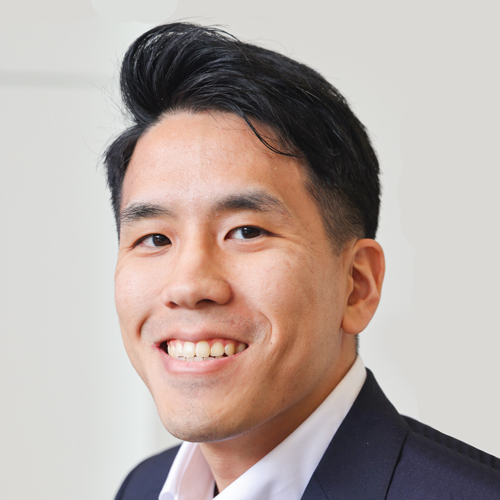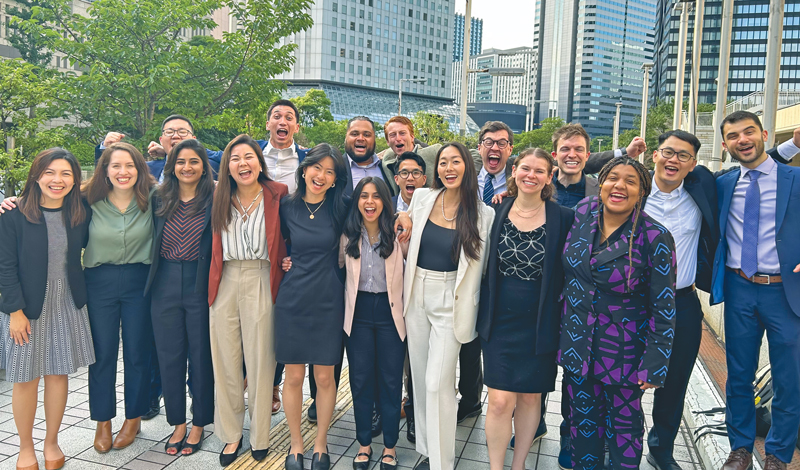

by Amelia Gonzalez Tesch and Shota Okajima
SGI-USA Young Women’s Division and SGI-USA Young Men’s Division Leaders
We so appreciate the opportunity to represent the SGI-USA at the 2024 SGI Youth Training Course. From June 26 to July 2, 18 youth from the SGI-USA were among 260 representatives from 60 countries and territories who gathered in Japan to seek from our eternal mentor, Ikeda Sensei, in the first youth training course since his passing. We felt an incredible sense of responsibility to carry forward Sensei’s legacy in his stead—and fully empowered to take the lead in advancing kosen-rufu—standing up as one world, together with Sensei.
Throughout five days, we attended many activities in Tokyo with the spirit to bring back Sensei’s heart for kosen-rufu. We’d like to share several key takeaways from our time in Japan.
Take Full Responsibility for Kosen-rufu
In the opening session, SGI Senior Vice President Yoshiki Tanigawa shared the guidance Ikeda Sensei had given him when he was a youth. In March 1990, upon his appointment as the Soka Gakkai’s national young men’s leader, it was suggested to Mr. Tanigawa to set a goal to gather 2 million youth.
The following month, Mr. Tanigawa shared his determination at a national youth leaders meeting with Sensei in attendance, saying it was suggested to gather 2 million members, and he would fight to achieve the goal. Sensei strictly called out his attitude, saying that a true battle is not waged by being told to do something. He continued: “A true battle is one that you ‘own,’ in which you yourself decide on a goal and take full responsibility to achieve it through your own diligent efforts” (June 10, 2022, World Tribune, p. 8).
Mr. Tanigawa shared that he learned then that the most important quality of a leader is the ability to take full responsibility for kosen-rufu. He urged the training course participants to take full responsibility for peace in their respective lands and advance together as disciples of Sensei.
At the start of the opening session, we each received a packet of 15 passages from Nichiren Daishonin’s writings (see pp. 26–27). Mr. Tanigawa asked us to engrave the passages in our lives so that we could recite them by heart and build a solid understanding of Buddhism through studying Nichiren’s writings. He then recited each of the 15 Gosho passages from memory.
Later that day, we attended a study session with SGI Study Department Leader Seiichiro Harada, in which he also emphasized the importance of studying the Gosho. He asked us to keep three points in mind based on Sensei’s guidance:
1. Read the Gosho with faith and profound conviction that we are reading the truth, the absolute truth—that this is exactly how it is.
2. Read the passages aloud again and again in a clear, strong voice—to the point where we have practically memorized it.
3. Read them in action, word and thought. This means resolving to live according to it: sharing its philosophy with others and practicing its teachings ourselves. (See The New Human Revolution, vol. 6, revised edition, pp. 284–85)
Learning From Sensei’s Actions
On June 28, we toured the Kanagawa Culture Center—a place that holds special significance in the history of our Soka Gakkai movement. In 1979, after Sensei stepped down as third Soka Gakkai president to protect the members from the authoritarian and corrupt Nichiren Shoshu priesthood, he chose not to go to the Soka Gakkai Headquarters but instead to the Kanagawa Culture Center. The center, located above a port that faces the Pacific Ocean, symbolized Sensei’s determination to spread the ideals of Buddhist humanism throughout the world. There, he made a powerful determination to stand alone in spreading Nichiren Buddhism.
Although Sensei was restricted from making public speeches, meeting with members in large groups and having his photos appear in the Seikyo Shimbun, his spirit didn’t change at all. It was shared with us that he frequented the local park and community shops, met with countless people and carried on his eternal struggle for the Law.
When we asked about the significance of the center, it was explained that Kanagawa is defined by the actions Sensei took there and that rather than think Kanagawa is a special place, we should strive to learn what Sensei did, how he encouraged the members, what he was thinking. Sensei’s spirit did not waver; he instead focused on encouraging one person at a time, visiting hundreds. He made an even deeper resolve in the most difficult times and launched a new era of worldwide kosen-rufu.
In the previously mentioned study session with Mr. Harada, he introduced a Gosho passage:
Great events never have minor omens. When great evil occurs, great good follows. Since great slander already exists in our land, the great correct Law [Nam-myoho-renge-kyo] will spread without fail. (The Writings of Nichiren Daishonin, vol. 1, p. 1119)
Based on these words from Nichiren, Mr. Harada shared the following guidance from Sensei: “It is how we react when something bad occurs that is important. If we make up our minds to enact a wonderful drama, summon forth the heart of a lion king and take bold action, we can transform great evil into great good” (July 2021 Living Buddhism, p. 59). We felt that Sensei’s actions in Kanagawa were the actualization of turning great evil into great good and renewed our resolve to spread Buddhism broadly in America because of the chaos in our world.
A New Generation of Disciples
On the afternoon of June 29, we attended the 3rd Soka Gakkai Headquarters Leaders Meeting, held at the Tokyo Toda Memorial Hall. Displayed for the first time was a beautiful portrait of Sensei alongside the portraits of founding Soka Gakkai President Tsunesaburo Makiguchi and second Soka Gakkai President Josei Toda.
Soka Gakkai Senior Vice President Hiromasa Ikeda introduced two of Sensei’s calligraphies: “Courageous Dance” and “Twenty-first Century.” They reflected Sensei’s trust in the youth of Soka.
During the meeting, five SGI youth representatives shared their determinations. On behalf of the SGI-USA, we shared about our victorious March Youth Peace Festivals, in which we gathered 11,347 youth, our first decisive battle after Sensei’s passing. We also voiced our determination to create momentum in our Summer of Shakubuku toward a victorious Soka Gakkai centennial. We felt that more than ever, our victory in 2030 starts with being victorious today and every day leading up to November 18, 2030.
We also learned that this was the first headquarters leaders meeting to be planned by a core of youth who were empowered to use their creativity. It was a fresh meeting signaling a new generation of disciples being entrusted to fully take the lead.
Make the Sanctity of Life the Global Ethos
On July 1, the final day of the training course, a Q&A guidance session was held with Soka Gakkai President Minoru Harada.
President Harada introduced Sensei’s guidance about the Seven Bells from the 35th Headquarters Leaders Meeting held in 1972. The Seven Bells are a series of seven-year periods outlining targets for the Soka Gakkai’s development based on President Toda’s determination to “sound a bell every seven years to mark our progress toward kosen-rufu.”
The Second Seven Bells (2001 to 2050) and the Third Seven Bells (2051 to 2100) would make up the 21st century. Sensei declared that this century would be a Century of Life, a time when the life philosophy of Nichiren Daishonin would become the global ethos, bringing to fruition an era based on the sanctity of life.
This year we have entered the midpoint of the Second Seven Bells (2001–2050). President Harada said that since Sensei’s passing, we are standing at a crucial juncture to usher in a new era of global kosen-rufu and that it is up to all of us to actualize Sensei’s grand vision for this century. He encouraged all of us to set out on the second half of this Seven Bells and work solidly, steadily and patiently to spread Buddhism in our communities, always keeping Sensei in our hearts and having dialogues with him along the way.
We came back more determined than ever to spread Buddhism in our communities and make the Century of Life a reality, through our efforts as one world with Sensei!
15 Gosho Passages to Live By
Prayer
- I am praying that, no matter how troubled the times may become, the Lotus Sutra and the ten demon daughters will protect all of you, praying as earnestly as though to produce fire from damp wood, or to obtain water from parched ground. There are many other matters to discuss, but I will close here. (“On Rebuking Slander of the Law and Eradicating Sins,” WND-1, 444).
2. Whether or not your prayer is answered will depend on your faith; [if it is not] I will in no way be to blame.
When water is clear, the moon is reflected. When the wind blows, the trees shake. Our minds are like the water. Faith that is weak is like muddy water, while faith that is brave is like clear water. Understand that the trees are like principles, and the wind that shakes them is like the recitation of the sutra. (“Reply to the Lay Nun Nichigon,” WND-1, 1079)
3. This is similar to a tarnished mirror that will shine like a jewel when polished. A mind now clouded by the illusions of the innate darkness of life is like a tarnished mirror, but when polished, it is sure to become like a clear mirror, reflecting the essential nature of phenomena and the true aspect of reality. Arouse deep faith, and diligently polish your mirror day and night. How should you polish it? Only by chanting Nam-myoho-renge-kyo. (“On Attaining Buddhahood in This Lifetime,” WND-1, 4)
4. When you shake your head, your hair sways; when your mind begins to work, your body moves. When a strong wind blows, the grass and trees can no longer remain still; when the earth shakes, the seas are atremble. Thus if one can move Shakyamuni Buddha, the lord of teachings, can the grass and trees fail to respond, can the waters remain calm? (“The Buddha Statue Fashioned by Nichigen-nyo,” WND-2, 811)
5. Though one might point at the earth and miss it, though one might bind up the sky, though the tides might cease to ebb and flow and the sun rise in the west, it could never come about that the prayers of the practitioner of the Lotus Sutra would go unanswered. (“On Prayer,” WND-1, 345)
Sharing Nichiren Buddhism
6. Therefore, one should by all means persist in preaching the Lotus Sutra and causing them to hear it. Those who put their faith in it will surely attain Buddhahood, while those who slander it will establish a “poison-drum relationship” with it and will likewise attain Buddhahood.
In any event, the seeds of Buddhahood exist nowhere apart from the Lotus Sutra. (“Those Initially Aspiring to the Way,” WND-1, 882)
7. Exert yourself in the two ways of practice and study. Without practice and study, there can be no Buddhism. You must not only persevere yourself; you must also teach others. Both practice and study arise from faith. Teach others to the best of your ability, even if it is only a single sentence or phrase. (“The True Aspect of All Phenomena,” WND-1, 386)
8. Single-mindedly chant Nam-myoho-renge-kyo and urge others to do the same; that will remain as the only memory of your present life in this human world. (“Embracing the Lotus Sutra,” WND-1, 64 )
Mentor and Disciple
9. It is said that, if a teacher has a good disciple, both will gain the fruit of Buddhahood, but if a teacher fosters a bad disciple, both will fall into hell.
If teacher and disciple are of different minds, they will never accomplish anything. (“Flowering and Bearing Grain,” WND-1, 909)
10. Therefore, those who become Nichiren’s disciples and lay believers should realize the profound karmic relationship they share with him and spread the Lotus Sutra as he does. Being known as a votary of the Lotus Sutra is a bitter, yet unavoidable, destiny. (“Letter to Jakunichi-bo,” WND-1, 994)
11. It must be ties of karma from the distant past that have destined you to become my disciple at a time like this. Shakyamuni and Many Treasures certainly realized this truth. The sutra’s statement, “Those persons who had heard the Law dwelled here and there in various Buddha lands, constantly reborn in company with their teachers,” cannot be false in any way. (“The Heritage of the Ultimate Law of Life,” WND-1, 217)
The Unity of Many in Body, One in Mind
12. Even an individual at cross purposes with himself is certain to end in failure. Yet a hundred or even a thousand people can definitely attain their goal, if they are of one mind. Though numerous, the Japanese will find it difficult to accomplish anything, because they are divided in spirit. In contrast, although Nichiren and his followers are few, because they are different in body, but united in mind, they will definitely accomplish their great mission of widely propagating the Lotus Sutra. Though evils may be numerous, they cannot prevail over a single great truth. (“Many in Body, One in Mind,” WND-1, 618)
13. Those people [the lay priest of Kawanobe and the others] are very important supporters of mine. But although I have prayed on their behalf so hard that my head was about to split, so far there has been no indication of my prayers being answered. It would seem that someone among them is wavering in faith. If one prays for a person who is not properly responsive in mind, it is like trying to light a fire on top of water, or to build a house in the empty air. (“Letter to Ben,” WND-2, 661)
14. Live so that all the people of Kamakura will say in your praise that Nakatsukasa Saburo Saemon-no-jo is diligent in the service of his lord, in the service of Buddhism, and in his concern for other people. More valuable than treasures in a storehouse are the treasures of the body, and the treasures of the heart are the most valuable of all. From the time you read this letter on, strive to accumulate the treasures of the heart! (“The Three Kinds of Treasure,” WND-1, 851)
15. All disciples and lay supporters of Nichiren should chant Nam-myoho-renge-kyo with the spirit of many in body but one in mind, transcending all differences among themselves to become as inseparable as fish and the water in which they swim. This spiritual bond is the basis for the universal transmission of the ultimate Law of life and death. Herein lies the true goal of Nichiren’s propagation. (“The Heritage of the Ultimate Law of Life,” WND-1, 217)
You are reading {{ meterCount }} of {{ meterMax }} free premium articles

